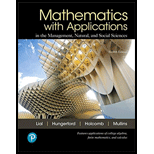
Concept explainers
Work the following marginal productivity problems. (See Example 6.)
A manufacturer estimates that production (in hundreds of units) is a function of the respective amounts x and y of labor and capital used, as follows:
Find the number of units produced when 27 units of labor and 64 units of capital are utilized.
Find and interpret
What would be the approximate effect on production of increasing labor by 1 unit?
What would be the approximate effect on production of increasing capital by 1 unit?
Want to see the full answer?
Check out a sample textbook solution
Chapter 14 Solutions
EBK MATHEMATICS WITH APPLICATIONS IN TH
- 11:18 91 chisholminstitute.bksblive2.com.au 1.5 ACSF L5 SC Geometry and Measure: Pythagorus' Theorum Pythagorean Problems Calculate the lengths of all of this triangle's sides. x = 64 cm² y A ↑ ४ 225 cm² + ? Image not drawn accurately. 45 45arrow_forwardWhat is WX explain your reasoningarrow_forwardUse the method of disks to find the volume of the solid that is obtained when the region under the curve y = over the interval [4,17] is rotated about the x-axis.arrow_forward
- search P(QP) Q 1.-P:PR 2.-QP:PR 3. Q:MT 1, 2 4. Q:DNE 3 Submit 4.5 P. (QP) Q 1. P: PR 2. Q-P PR 3. -Q:AS 4. -P:MP 2, 3 5. Submit 17 A Previous Chapter Next Chapterarrow_forward1. Find the area of the region enclosed between the curves y = x and y = x. Sketch the region.arrow_forwardfor the given rectangular coordinates, find two sets of polar coordinates for which 0≤θ<2π, one with r>0 and the other with r<0. (-2sqrt(3),9)arrow_forward
- Are the two statements A and B equivalent? (A) p~q (B) ~pq ☐ Statement A and B are equivalent. ☐ Statement A and B are not equivalent as their values in three rows are not identical. ☐ Statement A and B are not equivalent as their values in one row is not identical. ☐ Statement A and B are not equivalent as their values in two row are not identical.arrow_forwardLet p, q and r to be True, False and True statements, respectively. What are the values of the statements below. A: B: [(p→q)^~q]→r (pvq) → ~r O O A: False B: False A: True B: True A: False B: True A: True B: Falsearrow_forwardLet's assume p and q are true statements. What are the values of the statements below. A: (p→ q) →~p B: (p v~q) → ~(p^q) A: True B: False A: True B: True ☐ A: A: False B: False ☐ A: False B: Truearrow_forward
 Algebra and Trigonometry (MindTap Course List)AlgebraISBN:9781305071742Author:James Stewart, Lothar Redlin, Saleem WatsonPublisher:Cengage Learning
Algebra and Trigonometry (MindTap Course List)AlgebraISBN:9781305071742Author:James Stewart, Lothar Redlin, Saleem WatsonPublisher:Cengage Learning College AlgebraAlgebraISBN:9781305115545Author:James Stewart, Lothar Redlin, Saleem WatsonPublisher:Cengage LearningAlgebra & Trigonometry with Analytic GeometryAlgebraISBN:9781133382119Author:SwokowskiPublisher:Cengage
College AlgebraAlgebraISBN:9781305115545Author:James Stewart, Lothar Redlin, Saleem WatsonPublisher:Cengage LearningAlgebra & Trigonometry with Analytic GeometryAlgebraISBN:9781133382119Author:SwokowskiPublisher:Cengage Elementary Linear Algebra (MindTap Course List)AlgebraISBN:9781305658004Author:Ron LarsonPublisher:Cengage Learning
Elementary Linear Algebra (MindTap Course List)AlgebraISBN:9781305658004Author:Ron LarsonPublisher:Cengage Learning






